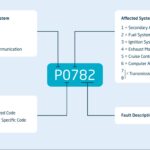Experiencing issues with your OBD2 device not powering up? It’s a common frustration, especially when you rely on these tools for vehicle diagnostics or tracking. When you plug your OBD2 scanner or plug-and-play unit into your car’s OBD-II port and it remains silent – no beep, no lights – it indicates a lack of power. Don’t worry, this guide will walk you through the most common causes and how to troubleshoot them, getting you back on track quickly.
Initial Checks: Ensuring Solid Connections
The simplest and most frequent culprit for an OBD2 device receiving no power is a loose or incorrect connection. Before diving into more complex diagnostics, let’s start with the basics: ensuring everything is properly plugged in.
Direct OBD2 Port Connection
If you are connecting your device directly to the OBD-II port, the fix might be as simple as reseating it.
- Unplug and Re-plug: Locate your vehicle’s OBD-II port (typically under the dashboard on the driver’s side). Unplug your OBD2 device completely.
- Firmly Reconnect: Plug the device back into the OBD-II port, ensuring it is firmly and securely connected. You should feel it click or seat properly.
- Listen for the Beep: If your device is designed to beep upon receiving power, listen carefully. A beep indicates successful power connection.
Troubleshooting with an OBD-II Extension Cable
Many users employ an OBD-II extension cable for convenience or specific installation needs. If you’re using a cable, potential connection issues can arise at both ends.
Checking the Cable-to-OBD-II Port Connection
- Disconnect from OBD-II Port: With your car’s engine turned off, unplug the extension cable from your vehicle’s OBD-II port.
- Wait and Reconnect: Wait for approximately 5 minutes before plugging the cable back into the OBD-II port. This brief pause can sometimes reset the connection.
- Listen for Power Indication: Observe your OBD2 device for any sign of power, such as a beep or indicator light, upon reconnecting the cable.
Inspecting the Cable-to-Device Connection
If you still don’t have power, the issue might be between the extension cable and your OBD2 device.
- Disconnect Device from Cable: Turn off the engine and unplug your OBD2 device from the extension cable.
- Wait and Reconnect: Allow 5 minutes to pass, then firmly plug the OBD2 device back into the extension cable.
- Check for Power: Again, listen for a beep or check for any power indicators on your device.
Verifying Device Functionality
To isolate whether the problem lies with your OBD2 device itself or the vehicle’s power supply, a simple test can be performed.
- Disconnect Cable: If you are using an extension cable, disconnect it from both the OBD-II port and your OBD2 device.
- Direct Connection Test: Plug your OBD2 device directly into the vehicle’s OBD-II port, bypassing the extension cable entirely.
- Observe for Power: If the device powers on and functions correctly when directly connected, the problem is likely with the extension cable or its fuse (if it has one).
Examining the Extension Cable Fuse
Some OBD-II extension cables incorporate a fuse to protect connected devices. A blown fuse in the cable can prevent power from reaching your OBD2 device.
- Locate Fuse Holder: Identify the fuse holder on your OBD-II extension cable. It’s usually a small, capped compartment.
- Inspect the Fuse: Open the fuse holder and carefully remove the fuse. Examine the fuse wire – if it’s broken or blackened, the fuse is blown.
- Fuse Replacement: Replace the blown fuse with a new fuse of the same type and amperage (typically a 3A mini-blade fuse, readily available at auto parts stores). Ensure the replacement fuse is properly seated in the holder.
- Test for Power: With the new fuse installed, reconnect the cable and your OBD2 device and check if power is now being supplied.
Checking the OBD-II Port and Vehicle Fuses
If all cable and device checks are clear, the issue might reside within your vehicle’s OBD-II port or its associated fuses.
-
Multimeter Voltage Test: Use a digital multimeter to test the voltage at your vehicle’s OBD-II port. You’ll need to check specific pins:
- Pin 16: Power (should read approximately 12V with the ignition on or off, depending on the vehicle).
- Pin 4 & 5: Ground (chassis ground and signal ground – should show continuity to ground).
If the multimeter reads 0 volts at Pin 16, there’s no power reaching the port.
-
Vehicle Fuse Inspection: Consult your vehicle’s owner’s manual to locate the fuse box diagram. Look for fuses related to “auxiliary power,” “cigarette lighter,” or “OBD-II port.” These circuits are often linked.
-
Check for Blown Fuses: Visually inspect the identified fuses. If a fuse is blown, replace it with a new fuse of the correct amperage.
When to Seek Professional Assistance
After performing these troubleshooting steps, if your OBD2 device still has no power, it may indicate a more complex electrical issue within your vehicle or a faulty OBD2 device.
At this stage, it’s advisable to:
- Consult a Qualified Mechanic: A professional mechanic can further diagnose the OBD-II port, wiring, and vehicle’s electrical system.
- Contact Device Support: If you suspect a faulty OBD2 device, reach out to the manufacturer’s support for further guidance and potential replacement options.
By following these steps, you can systematically diagnose and often resolve the issue of “My Obd2 Has No Power,” ensuring your diagnostic or tracking tools are operational. Remember to always consult your vehicle’s manual and exercise caution when working with electrical components.

